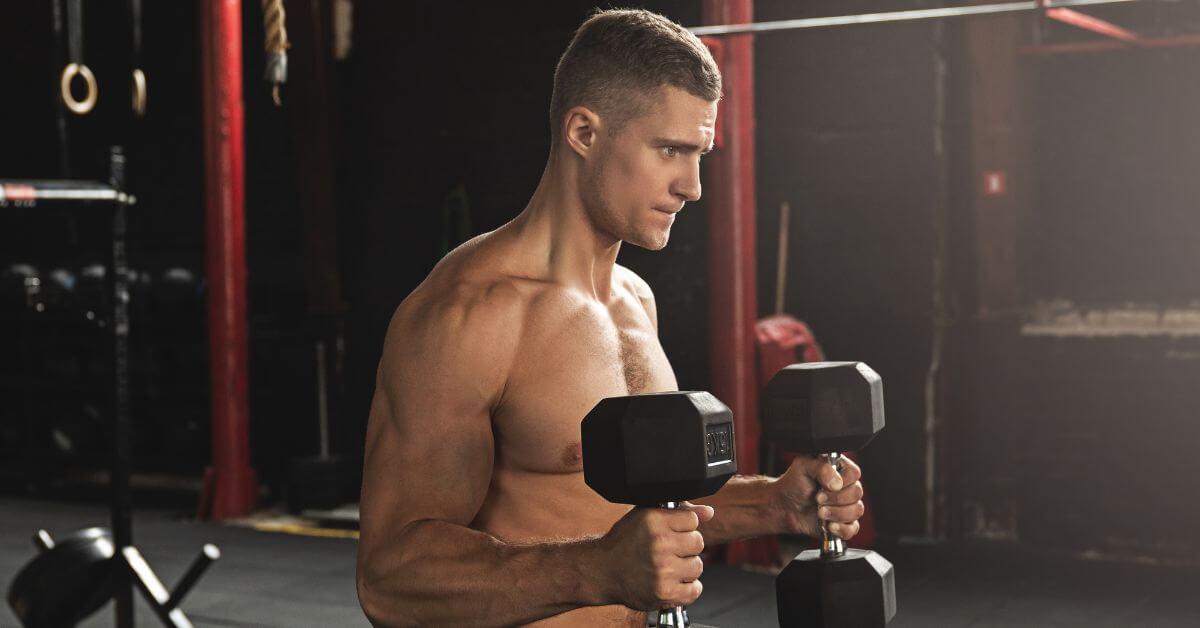Functional arm exercises assist your arms in getting stronger and more toned while also enhancing your capacity to carry out daily tasks. Incorporating functional trainer arm workouts can significantly boost your overall arm performance.
Table of Contents
ToggleThese exercises concentrate on activities like reaching, pulling, pushing, and lifting that we perform on a regular basis.
You may increase your arm strength and general health by including these compound movements in your workout routine, which will also make daily tasks simpler and easier to handle.
In this blog article, we’ll explore functional arm exercises, their benefits for people of all fitness levels, and how they work.
We’ll also go over some particular exercises you may include in your training regimen to strengthen and improve the functionality of your arms.
Start Building Your Dream Body Today
Ready to elevate your fitness game without falling into the trap of dull, repetitive routines that just don’t deliver? Imagine sculpting your ideal physique and boosting your health, all while still enjoying life’s pleasures, like those irresistible weekend getaways and your aunt’s legendary cheesecake. With our online fitness and nutrition coaching service, you don’t have to compromise. Dive into a personalized fitness journey that blends perfectly with your lifestyle, not against it. Book your completely free discovery consultation today, and take the first step towards a transformation that doesn’t require giving up the joys of life.

“I was skeptical about online fitness coaching, but Functional Body Savage completely changed my perspective. Vanja and Radomir’s personalized approach and attention to detail have helped me achieve goals I never thought possible. I’m stronger, more confident, and grateful for their guidance.”
Emily Thompson, San Francisco, CA
Learn More About Our Online Coaching ServiceQuick Summary
- For bettering overall fitness and daily activities, it’s crucial to develop functional arm strength.
- It is possible to increase arm strength and functional capacity by including a range of exercises that concentrate on various muscle groups, movement patterns, and planes of motion.
- It is not advisable to train your arms every day since your muscles require rest.
- Focus on the perfect form while progressively adding weight or resistance throughout a 30 to 60 minutes arm workout.
- Some of the greatest equipment choices for developing functional arm strength are dumbbells, kettlebells, and your own body weight.
10 Exercises for Functional Arm Strength
Here we have 10 arm exercises that work various muscle groups in the entire upper body to build functional arm strength.
To ensure that you comprehend the correct form and technique, we will go through each exercise in depth. Including these upper body functional exercises can provide comprehensive arm conditioning, enhancing both strength and endurance.
Do not forget to begin with lesser weights and raise them gradually as you gain strength and comfort performing each exercise. Let’s get started!
1. Tripod Db Elbowing Row
This exercise is a staple in any functional arm workout, targeting multiple muscle groups for maximum effectiveness. The tripod dumbbell elbowing row primarily targets the muscles of the upper back, including the rhomboids, trapezius, and rear deltoids, as well as the biceps and forearms.
It falls under the horizontal pull movement pattern, and you’ll need a stability ball, bench, or other sturdy object to support yourself in addition to a set of dumbbells.

How to Perform a Tripod Db Elbowing Row
- Begin by placing your right arm and right knee on a bench, with your left foot on the ground.
- Hold a dumbbell or kettlebell in your left hand, palm towards your body.
- With your elbow close to your body, draw the weight up towards your armpit, pulling your shoulder blades together at the apex of the exercise.
- Slowly lower the weight to the starting position
2. Kettlebell Pullover
The kettlebell pullover belongs to the horizontal push movement pattern and is a terrific exercise for building functional arm strength and upper body mobility. This move is an excellent example of functional bicep exercises, enhancing both strength and flexibility.
Utilizing your chest, lats, triceps, and core, you thrust your arms up and over your head while using a kettlebell in this exercise.
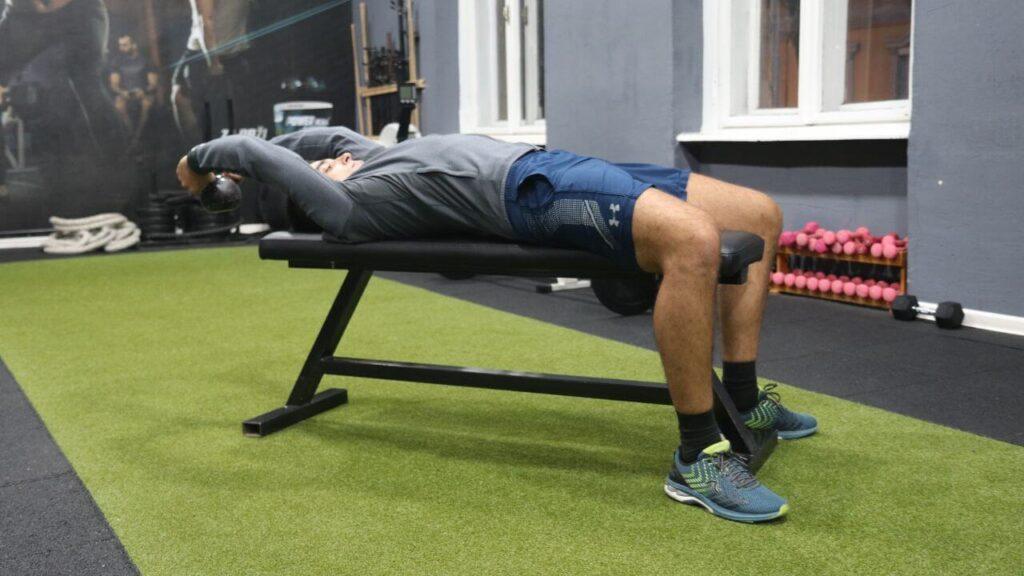
How to Perform a Kettlebell Pullover
- Knees bent and feet flat on the ground, lie on your back on the bench.
- Grasp the kettlebell by the sides of the handle with both hands.
- Start by raising the kettlebell above so that it is parallel to the bench.
- Lower the kettlebell back behind your head toward the floor while maintaining a straight arm position.
- As your chest and lats start to feel stretched, halt briefly before going back to the beginning position.
- After you finish a certain number of repetitions do the opposite side.
3. Sandbag Bear Hug Hold
The sandbag bear hug hold is an exercise that primarily works the muscles in your upper back, shoulders, and arms while also working your core and leg muscles. It is one of the best arm power exercises for improving overall functional strength.
Use of a sandbag, medicine ball or other heavy item is necessary for this exercise, which follows the isometric or static movement pattern.
It can enhance functional strength for tasks involving carrying or holding large things as well as grip strength and upper body stamina.
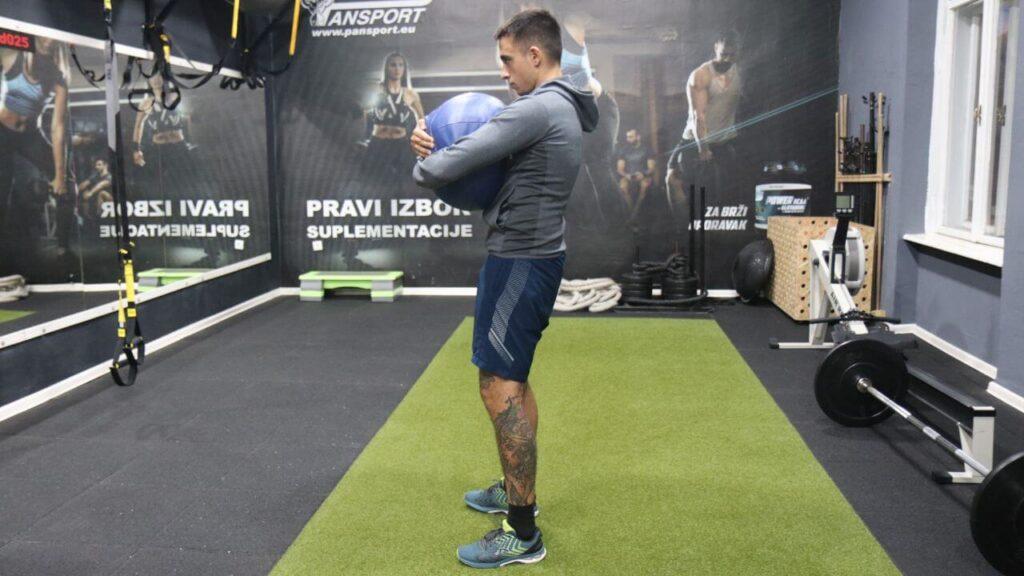
How to Perform a Sandbag Bear Hug Hold
- A heavy object, such as a sandbag, should be picked up and held at chest level with the palms facing inward.
- Hold the bag close to your body, with your back straight and your abs tight.
- Maintain the posture for the predetermined amount of time, usually 20 to 60 seconds.
- Repeat this process until the appropriate number of sets has been completed, lowering the sandbag down to the ground after a brief period of rest.
4. Heel Sit Landmine Press
The heel sit landmine press is a chest, shoulder, and arm exercise.
This exercise is part of the vertical pushing movement pattern and needs the usage of a landmine attachment and a barbell. Incorporating this into your upper body functional workout can significantly improve shoulder and arm strength.
It can enhance upper body strength, shoulder stability, and overhead pressing ability. However, implementing the standing unilateral landmine single-arm press can be a game-changer in terms of functional strength and joint stability.

How to Perform a Heel Sit Landmine Press
- Insert one end of a landmine device or barbell into a corner or landmine attachment while holding the other end in your hands.
- Sit on your heels, knees bent, back straight, and core engaged.
- Overhand grasp the barbell with your hands directly outside your shoulders.
- After you press the barbell up above, hold your arms straight and keep your elbows close to your trunk.
- Drop the barbell back to the beginning position and repeat as many times as you like.
5. Hellraiser Plank/Plank up Down
The hellraiser plank, also known as the plank up down, is a difficult exercise that works the core muscles, particularly the obliques, as well as the shoulders and triceps, and requires no special equipment to complete. This exercise is a great addition to any functional tricep exercises routine.
It also combines a static plank hold with a dynamic push-up action and belongs to the isometric and dynamic movement patterns.
Throughout the exercise, focus on core activation and avoid allowing your hips to drop or your shoulders to slouch up towards your ears.
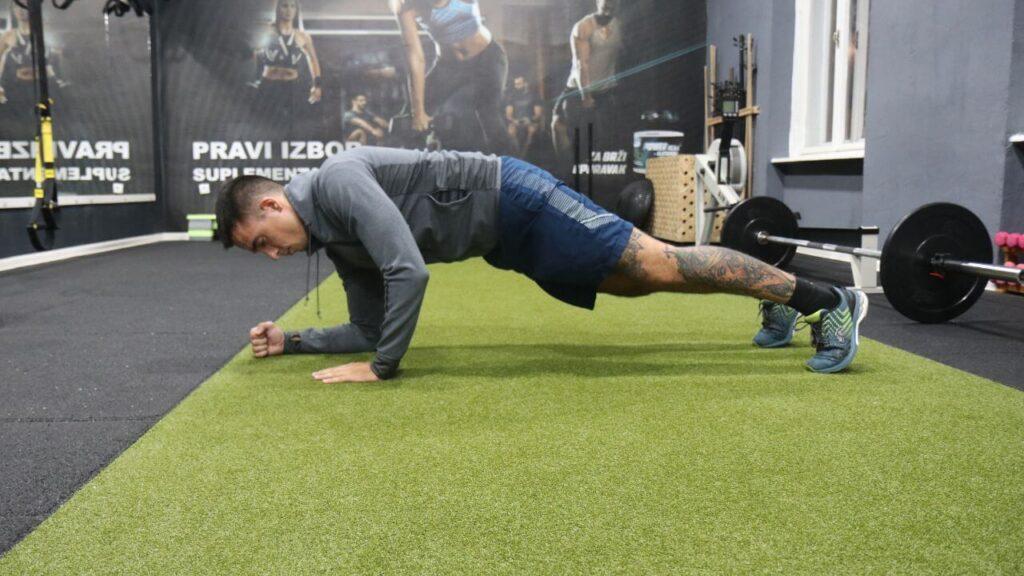
How to Perform a Hellraiser Plank/Plank up Down
- Start off in a high plank position with your feet hip-width apart, legs straight, and your hands under your shoulders.
- Maintain a straight line from your head to your heels while engaging your core.
- Reach a low plank posture by lowering onto one forearm, then the other.
- To get back into a high plank position, push up with one hand, then the other.
- Alternate which arm pushes up first as you perform the motion again.
6. High Plank Shoulder Taps/Plank Tap
The high plank shoulder taps, often referred to as plank taps, are a powerful exercise for developing core stability and strength as well as shoulder and triceps strength. They are essential in any functional training arms regimen.
There is no equipment needed for this exercise, which uses an isometric movement pattern.
Avoiding any hip twisting or shifting is crucial to maintaining appropriate form throughout the exercise.

How to Perform a High Plank Shoulder Taps/Plank Taps
- When you begin, arrange yourself in a high plank position with your feet hip-width apart, legs straight, and your hands directly beneath your shoulders.
- From your head to your heels, keep your spine neutral and engage your core.
- Tap the opposing shoulder while removing one hand from the ground.
- Then, repeat with the second hand by putting the first one back on the floor.
- As many times as you’d want to repeat, keep alternating the taps.
7. Hindu Push-Ups
The Hindu push-ups are a vigorous exercise for the entire upper body that focuses on the chest, shoulders, triceps, and back muscles. This is one of the most effective arm exercises for strength, engaging multiple muscle groups simultaneously.
This exercise belongs to the dynamic movement pattern, combining a push-up with a front bend and a back extension.
This workout requires no equipment and can be done anywhere.
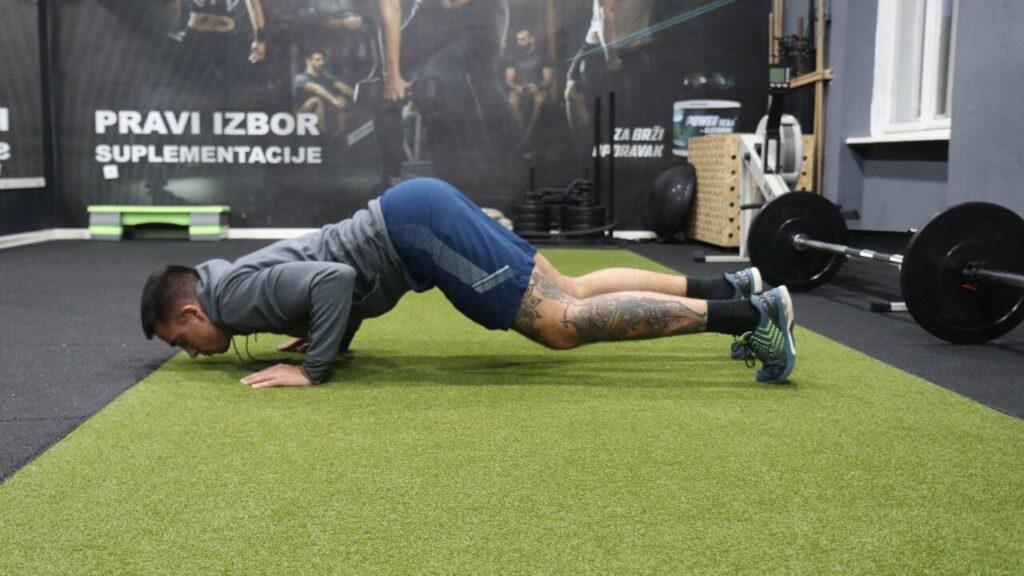
How to Perform a Hindu Push-Ups
- Begin in a high plank position and get yourself in a downward dog position, with hands and feet on the ground and hips up in the air.
- Drop your body to the ground, keeping your elbows close to your sides.
- Arch your back and elevate your head to the ceiling as you descend to the ground.
- Straighten your arms, lifting your hips back up towards the ceiling and lowering your head back down towards the ground.
- Then, repeat as many times as you like.
8. Standing Double Arm Overhead Dumbbell Triceps Extension
The standing double arm overhead dumbbell triceps extension is a triceps-focused exercise that also works the shoulders and upper back.
This exercise uses a dumbbell or other equivalent weight and relates to the vertical push movement pattern.
Maintain perfect form throughout the exercise by maintaining your elbow near to your ear and preventing any swinging or motion.
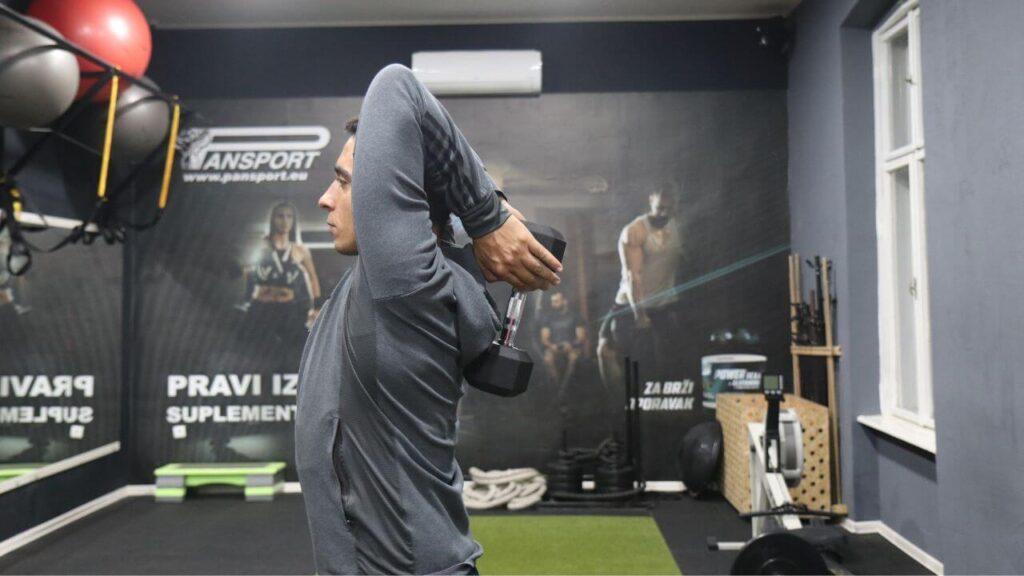
How to Perform a Standing Double Arm Overhead Dumbbell Triceps Extension
- You should stand with your feet shoulder-width apart, with a dumbbell in one hand.
- Keep your elbow near to your ear as you raise the dumbbell above your head.
- Bend your elbows and drop the dumbbell behind your head until your forearms are in contact with your bicep.
- At the bottom of the motion, pause, straighten your arms, and then resume your starting position.
- Repeat as many times as necessary before switching arms.
9. Kettlebell Hammer Curl
The kettlebell hammer curl is an excellent exercise for developing forearm and bicep strength and definition, which are necessary for pulling and grasping motions.
It requires the usage of a kettlebell and is a part of the isolated movement pattern.
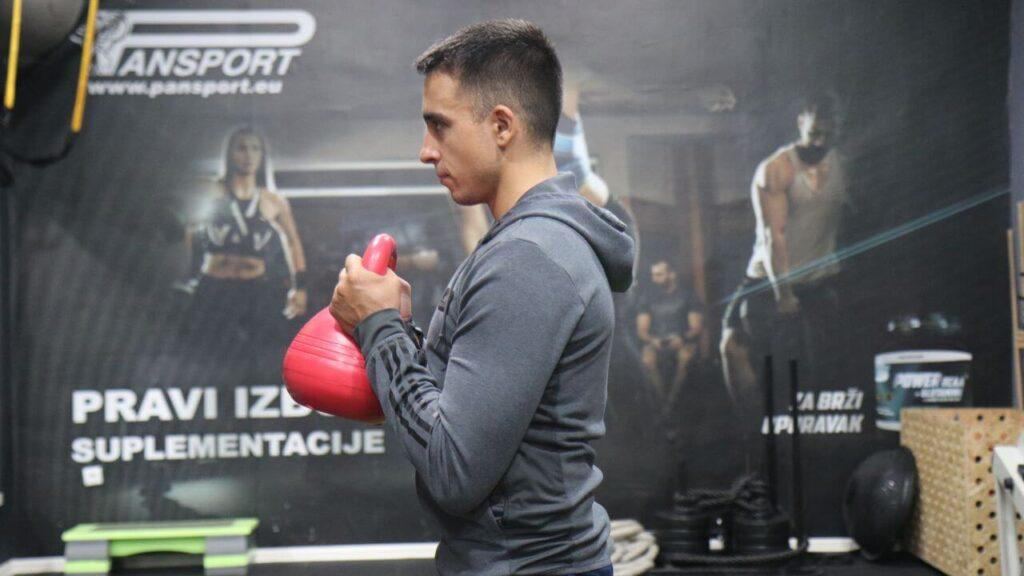
How to Perform a Kettlebell Hammer Curl
- Start by assuming a standing position, keeping your feet shoulder-width apart, fingertips pointing forward, and a kettlebell in each hand.
- Your elbows should be close to your body and your hands should be pointing inward.
- With straight wrists and immovable elbows, slowly curl the weights toward your shoulders.
- After your biceps are completely extended, wait for a moment before lowering the weights back to the starting position.
- The exercise should be repeated as many times as needed.
10. Kettlebell Farmers Hold
The kettlebell farmers hold is an exercise that primarily focuses on core, arm, grip strength, and posture muscles.
This exercise is part of the static hold movement pattern, which includes holding a weight or item in a fixed posture for a length of time, and it calls for a pair of equal-weight kettlebells.
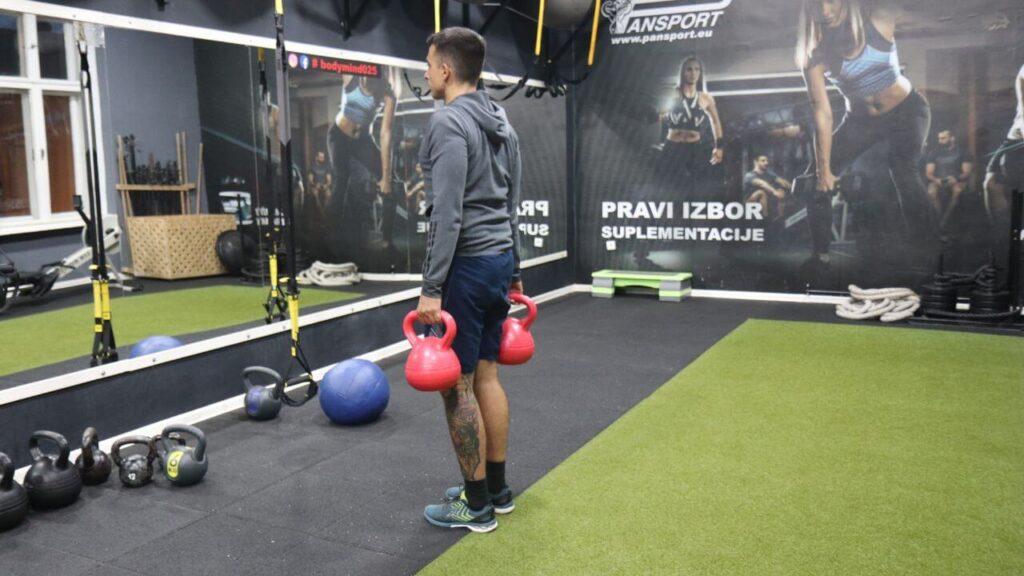
How to Perform a Kettlebell Farmers Hold
- Put your feet shoulder-width apart and stand tall with your right and left arm straight.
- With a kettlebell in each hand, with the palms facing inside, hold them by your sides.
- Ensure that your shoulders are tucked in and back, and tense your abdominal muscles.
- During a period of time you choose, often between 30 seconds and one minute, maintain this posture.
- Slowly lower the kettlebells back to the ground.
Expert Reveals Key Technique for Maximizing Bicep Training
In a YouTube video, Dr. Mike, a Ph. D. in sports physiology, shares insights from fitness authority Meno Henselmans on optimizing bicep exercises for maximum tension throughout the full range of motion:
“Most people do biceps training traditionally with dumbbells or barbells, which is biomechanically suboptimal because in the bottom position there is no tension on the biceps. The bottom position is uniquely important for the biceps because it is where the muscle is relatively stretched, providing stretch-mediated hypertrophy. To ensure maximum tension throughout the entire range of motion, use a cable and adjust your position to maintain high tension in both the contracted and lengthened positions. This technique leverages both active and passive tension for optimal muscle growth.”
What Functional Strength Is and Why It Matters
Functional strength is a subset of strength that focuses on enhancing the muscular strength and power that are employed in daily activities and motions.
To do activities like lifting large things, carrying groceries, or climbing stairs, it entails strengthening and training muscles to operate together.
Functional strength is the capacity to use your muscles effectively and efficiently to carry out daily tasks rather than simply having large muscles or lifting huge weights [1].
The ability to enhance overall health and quality of life is why functional strength is significant.
A person’s risk of injury can be decreased, balance and coordination can be strengthened, and overall physical capabilities can be enhanced by developing this type of strength through functional exercises.
Individuals may even do better in sports or other physical activities as a result, which can boost their confidence and independence in daily life [2].
Read our guide on how to train for functional strength to build a more functional, stronger, and resilient body.
“Function is, essentially, purpose. When we use the word function we are saying that something has a purpose.” – Michael Boyle, Strength and Conditioning and Strength Training Consultant
Related Articles:
- Functional Training 101: Ultimate Guide to Next-Level Fitness
- 15 Functional Shoulder Exercises for Strength & Mobility
- 7 Best Functional Chest Exercises and Workouts
- 10 Best Functional Upper Body Exercises for Strength
FAQs
What Exercises Work Entire Arms?
Exercises that work entire arms are pull-ups, push-ups, rows, bench presses, dips, and overhead presses.
Can I Train Arms Everyday?
No, you cannot train your arms every day since after working out, your muscles require time to rest and regenerate. A common guideline is to give the same muscle group at least 48 hours of rest before training it again.
How Long Does It Take To Build Arm Muscle?
It takes, generally, anywhere from several weeks to several months to see noticeable changes in your arm muscles.
How Long Should an Arm Workout Be?
An arm workout should be between 30 minutes to an hour long, including warm-up and rest periods.
What Is the Best Equipment for Building Functional Arm Strength?
While there are many different kinds of equipment available for developing functional arm strength, dumbbells, kettlebells, and your own body weight are the greatest choices.
These pieces of equipment offer a variety of workouts that may test your muscles in various ways and assist you in reaching your fitness objectives.
Read our guide on the best functional training equipment for 2024 to get you started with functional arm training.
Let me know in the comments below which functional arm exercise is your favorite and why.
Start Building Your Dream Body Today
Ready to elevate your fitness game without falling into the trap of dull, repetitive routines that just don’t deliver? Imagine sculpting your ideal physique and boosting your health, all while still enjoying life’s pleasures, like those irresistible weekend getaways and your aunt’s legendary cheesecake. With our online fitness and nutrition coaching service, you don’t have to compromise. Dive into a personalized fitness journey that blends perfectly with your lifestyle, not against it. Book your completely free discovery consultation today, and take the first step towards a transformation that doesn’t require giving up the joys of life.

“I was skeptical about online fitness coaching, but Functional Body Savage completely changed my perspective. Vanja and Radomir’s personalized approach and attention to detail have helped me achieve goals I never thought possible. I’m stronger, more confident, and grateful for their guidance.”
Emily Thompson, San Francisco, CA
Learn More About Our Online Coaching ServiceReferences:
- https://pubmed.ncbi.nlm.nih.gov/33618779/
- https://pubmed.ncbi.nlm.nih.gov/22777332/

